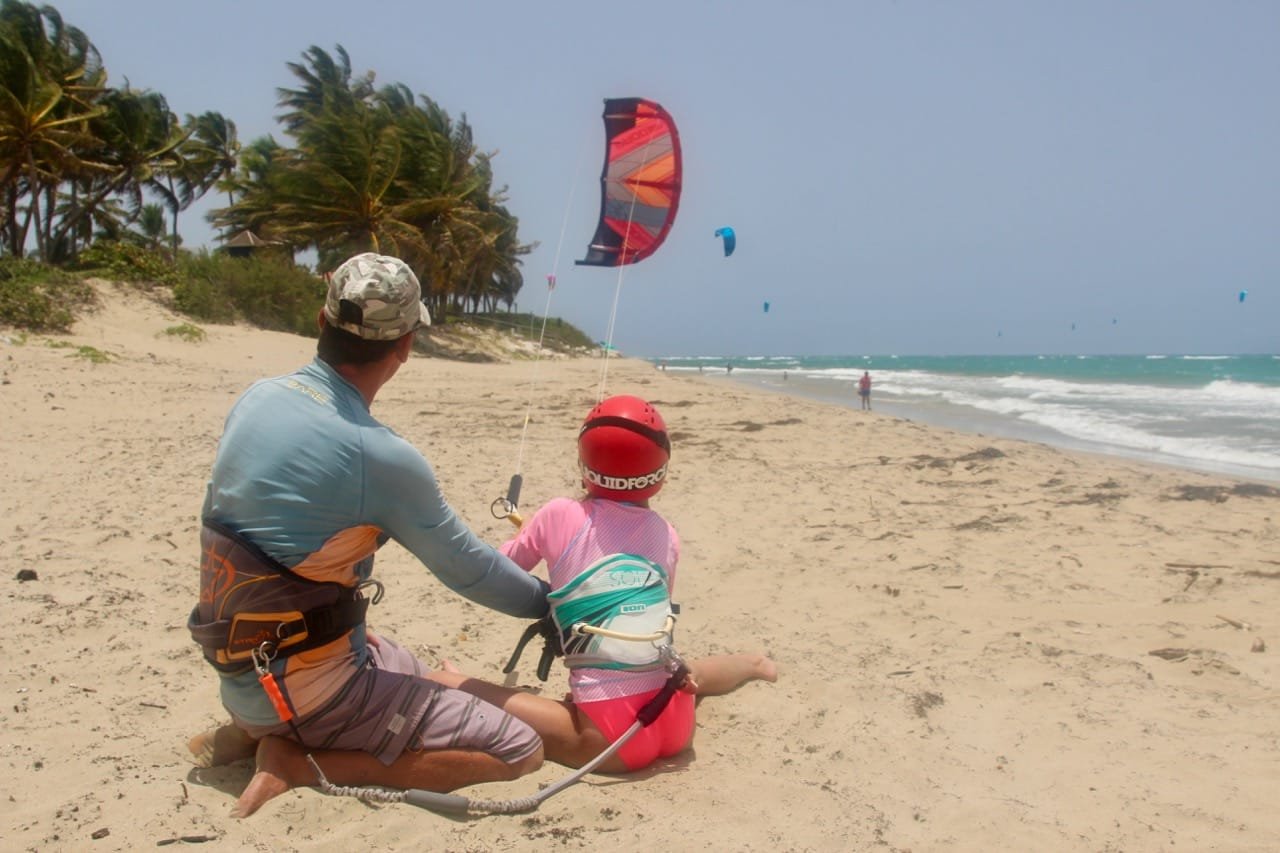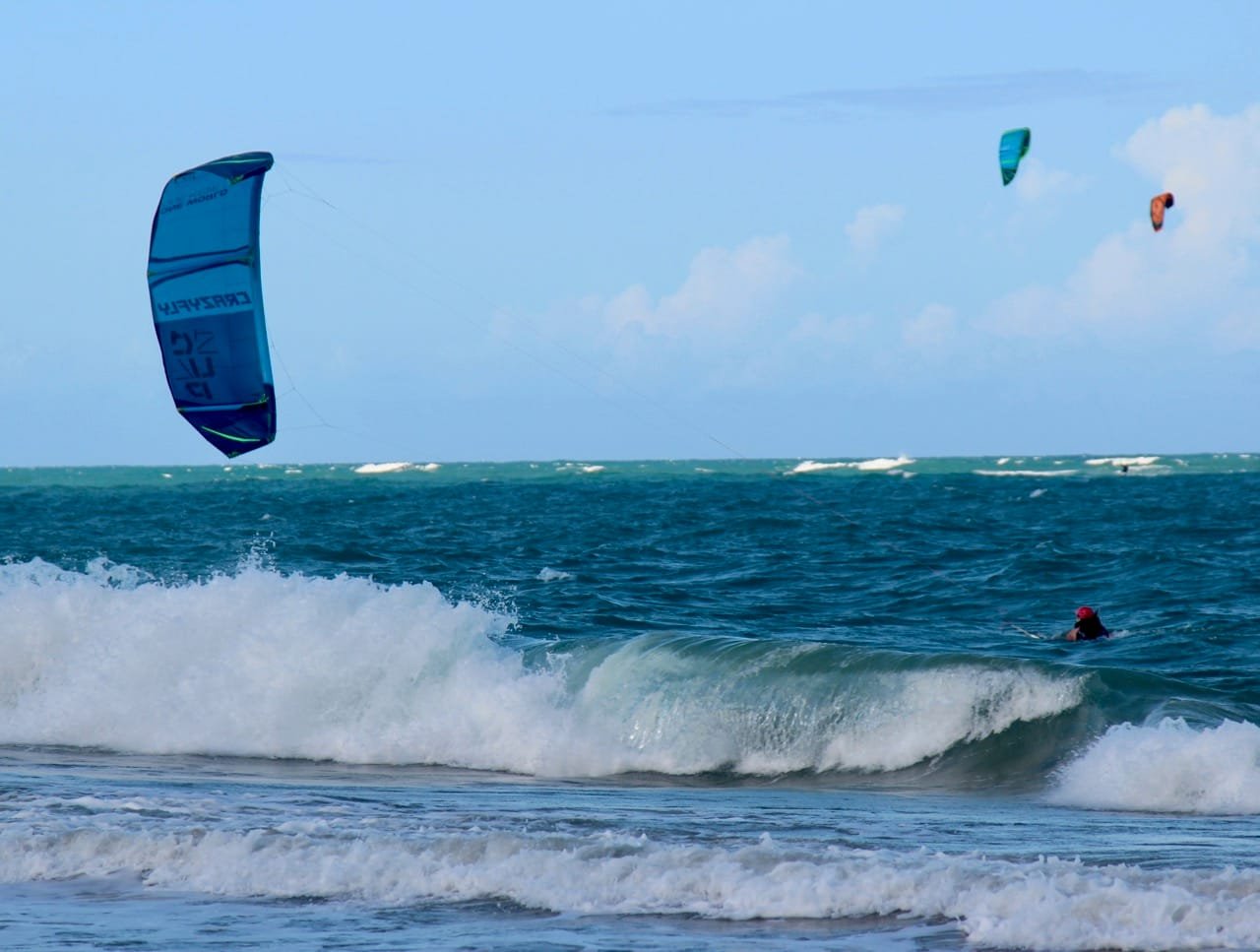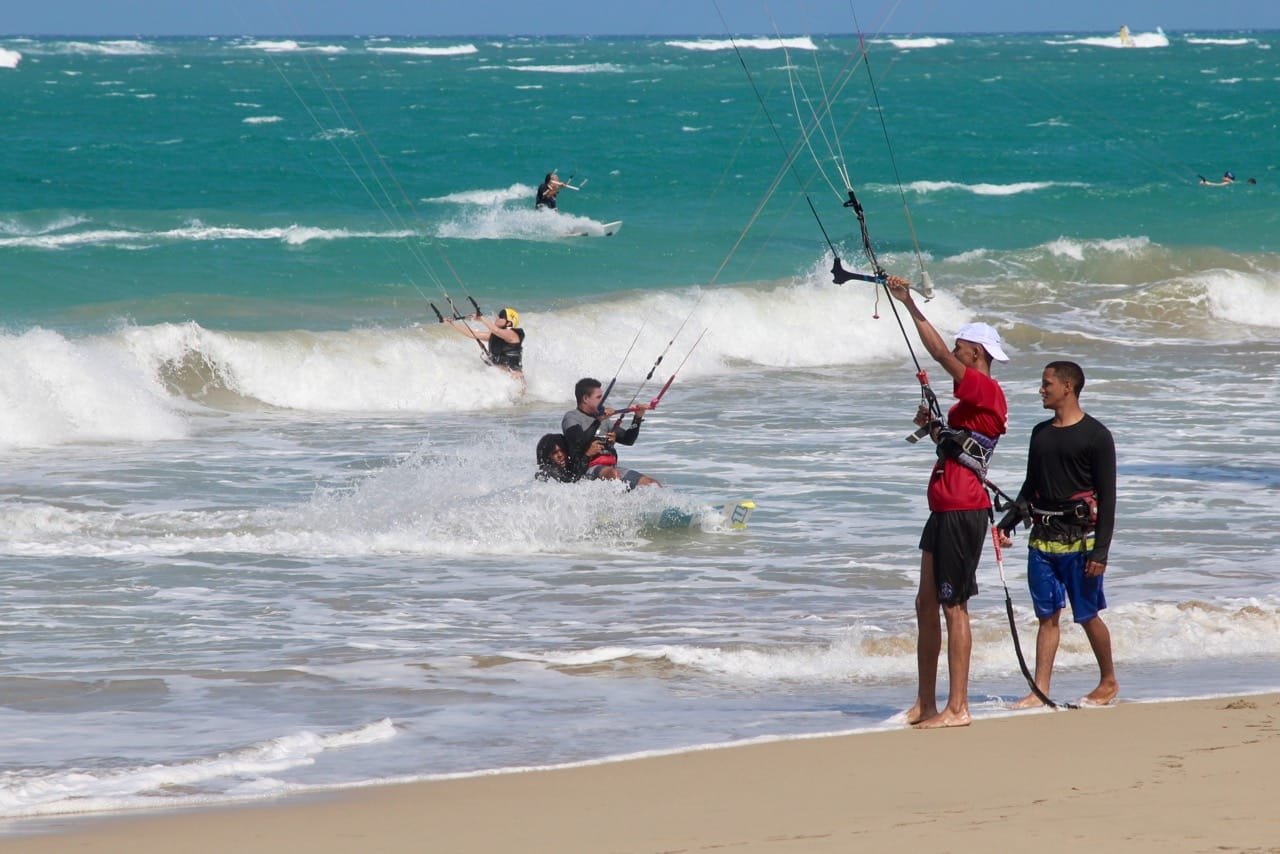Kitesurf lessons explained.

What is the process of learning kitesurfing at the DOMINIKITE kite school based on?
This article is for those who are planning to come to Cabarete and learn how to kitesurf.
I will not use any kite terminology here, but will only talk about the process of learning how to kitesurf at the DOMINIKITE kite school, and also answer frequently asked questions.
DESCRIPTION OF THE PROCESS OF LEARNING KITESURFING
What is the process of learning kitesurfing at the DOMINIKITE kite school based on?
The process of learning to kitesurf is a series of exercises aimed at developing certain reactions in you.
That is, the main task of the trainer during lessons is to help you develop automatic executions of this or that movement with your arms, legs, body, all muscles, to teach your body to react correctly to any situation on water or land when controlling a kite.
For example, we all know how to walk, but do we think while walking or running how this happens? Of course not.
This happens automatically, your brain itself gives a signal to the muscles what to do. In the process of learning to kitesurf, it is important to develop similar automatic reactions!
This approach to kitesurfing training guarantees safety and further stable progress.
You can call this learning style “bicycle” - once you’ve learned it, you’ll never forget it.
At each stage of training, your reactions will be brought to automaticity. This is the main key to success!

STAGES OF LEARNING KITESURFING.
Now about the stages. The entire process of learning to kitesurf can be divided into three stages:
I. Let’s call the first stage “SHORE”, here we will learn to confidently control the kite with both two and one hands while walking.
II. Second stage “WATER WITHOUT A BOARD”. At this stage we will learn how to pass the beach break, move in the water without a board to specific points, controlling only the kite.
III. Third stage “WATER WITH BOARD”. We will learn how to waterstart including putting on a board while in the water with a kite, start, stop, move through the water on the board in both directions, which is actually the final goal of the basic 10-hour training course. Next I will tell you more about each of the stages.

First, there will be a little theory, where we will find out the answers to the questions:
— how does the kite work? — what is the name of this thing on the kite? — why does the kite fly? — how to adjust the kite for windy conditions? — how to store equipment? — how to prepare the equipment before the gurney?
Then we will look at the basic safety rules when flying a kite on the shore and in the water. After getting the theoretical basics, let's move on to the exercises.
The main tasks at the first stage of learning to kitesurf:
- study the theory of kiting
- study safety rules
- learn how to independently raise and lower the kite
- learn to control the kite with one hand while walking
- develop reactions when controlling the kite as the foundation for future progress
During the "SHORE" stage we are fully prepared so that you can enter the water without paying much attention to the kite.
While in the water, you will be distracted from controlling the kite by many other things, such as other kiters, “those stupid waves and wind,” the blinding sun, a helmet getting in the way, etc.
Consequently, your reactions to the behavior of the kite at the first stage, before entering the water, should be such that it is automatic.
If you enter the water with poor reactions, then, unfortunately, you will not progress, but regress, since you will always be distracted by the kite, and not learn something new.
As a coach, I consider the first part of training “SHORE” to be the most important in learning to kite, this is the foundation, the basis of the basics.
Unfortunately, more than once we have had students come to our school with a “shore” that had not been taught comprehensively somewhere previously which resulted in a complete lack of understanding of the reasons for their regression.
To the student's frustration, we had to get out of the water and return to the beginning of the training. I really want to convey to you one important idea:
Don't rush to get on the water! Develop reactions! Forcing events at the first stage is ineffective and unsafe!
If you go out on the water unprepared, with unformed reactions, then you will continue to pay money for training in vain, since you will have to develop your reactions in an aggressive environment, and this is much more difficult, takes longer and, of course, more dangerous.
For the average person, 4-5 hours of training on the shore is enough. For most students, this is the longest stage of learning. At the end of the “Shore” stage,
I always tell my students that they can already start practicing snowkiting, since all the skiing takes place on shore in the snow and, in fact, after the first stage you are ready for it!

In the second stage of kitesurfing training we will learn how to get in and out of the water safely.
After all, getting through the beach break that can reach your height is a whole science!
Next, we will need to be able to move in the water to the point we want to get to, controlling the kite (also called body dragging).
This is a valuable skill that will come in handy many times in the future.
Orientation and movement in the water is necessary so that you can get back to your board if you lose it in a fall.
This is also important for self-rescue on the water in cases of equipment breakdown and in other unforeseen situations. Also, at the second stage of kitesurf training, re-launching the kite from the water is practiced and your reactions to controlling the kite when in a new water environment are strengthened.
After all, there will be other kiteboarders around you, who will be constantly distracting you from your tasks.
The main tasks of the second stage of kitesurfing training:
- be able to get into the water and get out of it, having passed the beach break
- be able to control the kite, navigate and move in the water to desired points
- be able to relaunch a kite that fell into the water
- consolidate kite control reactions in a new water environment
Based on my considerable experience in teaching kitesurfing, I can say that I have often met beginner kiters in Cabarete who had no previous experience in riding on real ocean spots, but had only practiced in calm water.
As a rule, these people have problems passing the beach break and are not able to enter the water on their own without the help of an instructor. And how many boards they lose! In addition, they need to continue to pay instructors at each new spot, as they need the support for safety reasons.
The conclusion is that they never received a full course of study for their money. Don't repeat other people's mistakes! Learn how to body drag! Learn how to pass the beach break!
Learn full control of the kite before entering the water! Remember the well-known saying: “It’s hard to learn, it’s easy to fight.” The second stage of learning kitesurfing is exactly about this, it is not the most pleasant, but very necessary.
On average, the “IN THE WATER WITHOUT THE BOARD” stage lasts 2-3 hours, after which you receive a board.

This is the final part of our kitesurfing learning process.
By the beginning of the third stage, you should already be able to confidently control the kite with one hand, independently and safely enter and exit the water in any beach break, travel through the water without a board with the kite in any direction, know the safety rules on shore and in the water.
In other words, your body must be ready to receive another object (the board) and focus on it, and not be distracted by controlling the kite. The main tasks of the third stage of kitesurf training:
- be able to get into the water with a board and get out of it, having passed the beach break
- while controlling only the kite, be able to get to the board if you lost it on the water
- correctly orient the board when starting
- start and move in both directions, standing on the board
The average student passes this stage in 2 hours of classes.
If the previous two stages are fixed and mastered like a “bicycle”, then two hours is enough to master the water start with a board.
Of course, the basic course is just the beginning of your kiting journey. For some it will be enough, for others they will continue to train, but that’s another story.
The 10-hour basic kitesurfing course is designed to provide independent riding skills.
At the end of the course, you can rent equipment or buy your own and continue to practice your acquired skills, ride, ride and ride again to become a confident and experienced kiter.

ANSWERS TO FREQUENTLY ASKED QUESTIONS
This is the question I hear most often and I hope that after reading the article above you already have the answer.
I want to add just one thing.
We are all different, our physical training, psycho-emotional state, brain reactions are different for everyone, which means the learning process cannot be the same for everyone.
Some people need more time on the shore, others more time on the water.
Now tell me - how can a trainer assess your abilities before starting training without knowing you?
If you come to a certain school and they give you a GUARANTEE that you will be riding in 10 hours, run away from this school.
Training should be focused on YOUR success, RESULTS, and take into account the individual characteristics of each person.
This is the average time required for a beginner to complete the three stages of the basic course.
These statistics are based on years of work with lots of different students, as well as statistics from other (good, result-oriented) schools.
One student becomes completely independent after 8 hours, another needs 12 or 15 hours. I repeat once again, everyone is different, 10 hours is the average time.
“How many hours a day will I be learning?” Again, everybody is different. But in most cases, I recommend lessons, for your pleasure and not to get overwhelmed, of 1.5 - 2 hours a day.
Since it is important for us to develop reactions, a training program of 5 days of 2 hour-lessons will be more effective than 2 days of 5 hour-lessons. It is advisable to give yourself one day of rest in the middle of the course, as our muscles have a habit of accumulating fatigue.
I often see dramatic progress in students after a day of rest.
“Do I need special equipment to learn kitesurfing?”
You will need comfortable shorts, lycra, sunglasses and sunscreen. You can read more about equipment for a beginner kiter in my article Kitesurfing Equipment
Kite school Dominikite and I, as a coach, adhere to two main principles when training: safety and results.
This is why we deliberately do not use walkie-talkies.
From a safety point of view, a walkie-talkie is an unnecessary item that distracts you from completing tasks. In terms of results, a walkie-talkie prevents you from becoming a self-sufficient kiter.
When you are in the water with a walkie-talkie, and the coach tells you what to do every time, will you really learn anything?
Will you get the necessary experience from mistakes and situations that require your and only your reaction? No. In addition, many students become dependent on the coach - it makes you feel safer. Consequently, the walkie-talkie slows down progress.
We came to this conclusion by teaching both with and without walkie-talkies.
The goal of the kite school is initially, from the first stage of training, to make you independent, thinking for yourself, making decisions for yourself, and not waiting for tips.
We are for quality training and results!
Having acquired the basic skills, the next thing you will need to pay attention to is the correct stance on the board and when on the water returning back to your starting point.
When you are confident about going in both directions, you can begin practicing turns without immersion in water and the first straight jumps.
At this stage, you can continue to study on your own; there are plenty of lessons on the Internet that explain the technique.
Or again seek the help of a trainer. Jumping, tricks and various techniques are already an advanced training course.
